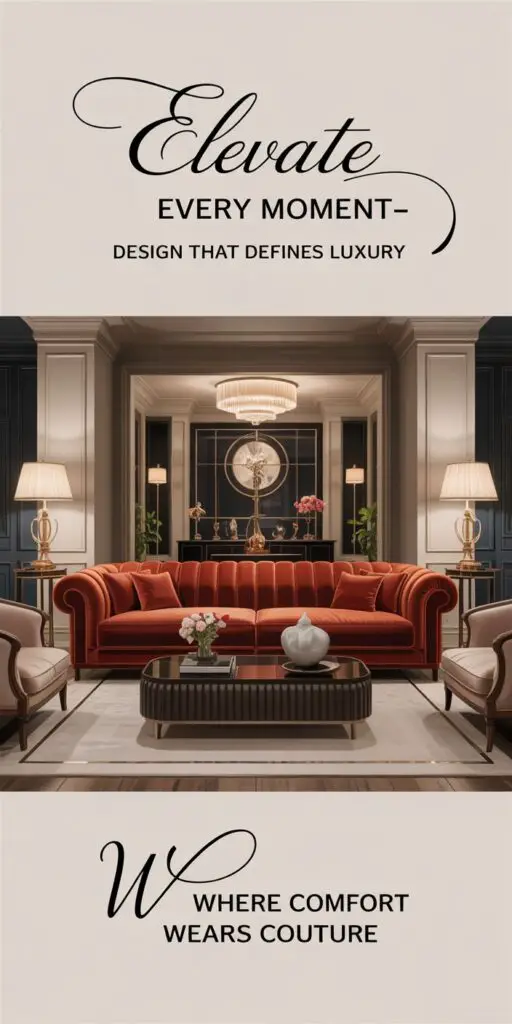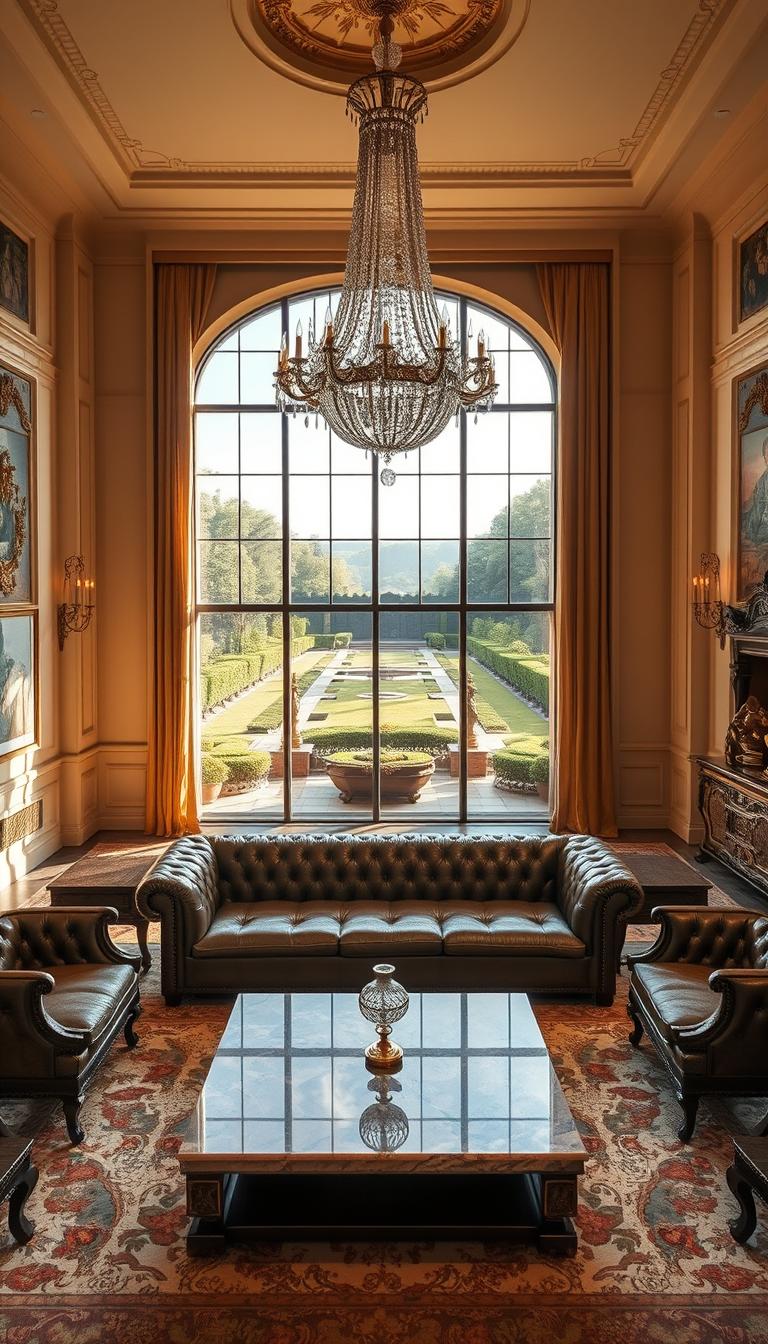I remember visiting a friend’s home last year—what struck me wasn’t just the plush sofa or the elegant lighting, but how every detail felt intentional.
That’s the magic of a well-designed space.
Creating a high-end look isn’t about filling a room with expensive items. It’s about curation. Whether your space is spacious or compact, the right balance of statement pieces and functionality makes all the difference. Experts like Louis Duncan-He emphasize that true elegance comes from personal touches, not just trends.
In this guide, I’ll walk you through a 12-step framework to blend aesthetics with everyday comfort. From smart material choices to lighting tricks, we’ll cover how to craft a space that reflects your version of sophistication—without sacrificing practicality.
Key Takeaways
- Intentional design works for any space size.
- Balance bold pieces with functional elements.
- Personal style defines true elegance.
- Material quality elevates the overall look.
- Lighting sets the mood for sophistication.
Start with a Sophisticated Color Palette
Color sets the mood before any furniture or decor enters the picture. I’ve seen clients hesitate between safe neutrals and bold hues, but the magic lies in balance. Follow the 60-30-10 rule: 60% dominant (walls), 30% secondary (furniture), and 10% accent (decor).
Neutrals as a Foundation
Benjamin Moore’s Simply White is my go-to base. It’s warm without yellow undertones, making it versatile for any style. Pair it with charcoal gray for depth—Traci Connell swears by black-and-white pairings for timeless appeal.
Moody Hues for Drama
Deep blues and grays create instant drama. House Nine Design Studio used navy on a feature wall, making the space feel intimate yet elegant. Farrow & Ball’s Hague Blue works wonders in formal areas.
| Neutrals | Moody Hues |
|---|---|
| Simply White (Benjamin Moore) | Hague Blue (Farrow & Ball) |
| Warm beige | Charcoal gray |
| Soft taupe | Emerald green |
Emerald green accents pop against neutral backdrops. Avoid overly bright shades—they can cheapen the aesthetic. Always test large swatches; lighting changes everything.
Remember: Paint is permanent, but decor isn’t. Start with a refined palette, then layer in personality.
Invest in High-End Furniture
Your sofa isn’t just a place to sit—it’s the anchor of your entire space. Quality furniture blends durability with design, creating a foundation that lasts. I learned this after replacing my budget couch twice in three years before investing in Alvin Wayne’s cloud-like sectional.
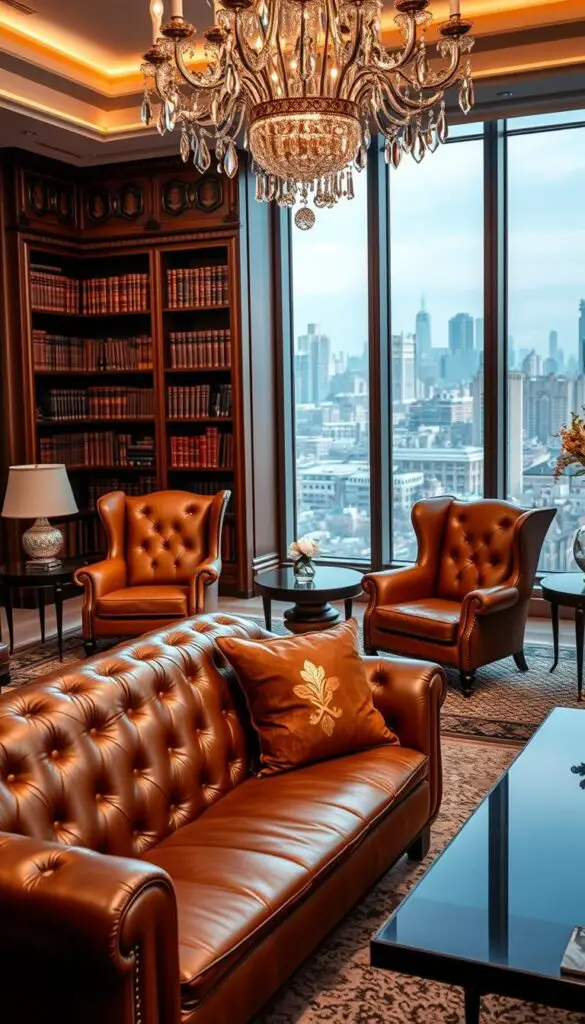
Opt for a Statement Sofa
Performance fabrics like Crypton resist stains but lack the richness of natural linen or velvet. For busy households, they’re practical. For a timeless look, consider these brands:
- Restoration Hardware: Cloud Sofa (investment piece with 10-year warranty)
- CB2: Jute-blend designs (mid-range)
- Article: Sustainable velvet options (budget-friendly)
Measure carefully: Leave 30″ walkways and match sofa depth to your height. My 5’2″ frame suits 22″-deep seats, while taller friends prefer 28″.
Leather Chairs for Timeless Elegance
Interior designer Kate Marker calls leather chairs “the little black dress of furniture.” Full-grain leather ages beautifully—unlike bonded leather, which cracks within years. Pair a Chesterfield-style chair with a velvet sofa for contrast.
Maintenance matters:
- Condition leather every 6 months
- Keep away from direct sunlight
- Use felt pads under metal legs
Brass legs add modern flair, while wooden bases offer warmth. Choose based on your color palette.
Layer Luxurious Fabrics and Textures
Texture is the secret weapon designers use to create depth and interest. When MR Architecture layered a chunky wool rug over polished concrete floors, the space instantly gained warmth. This contrast principle works for any design style.
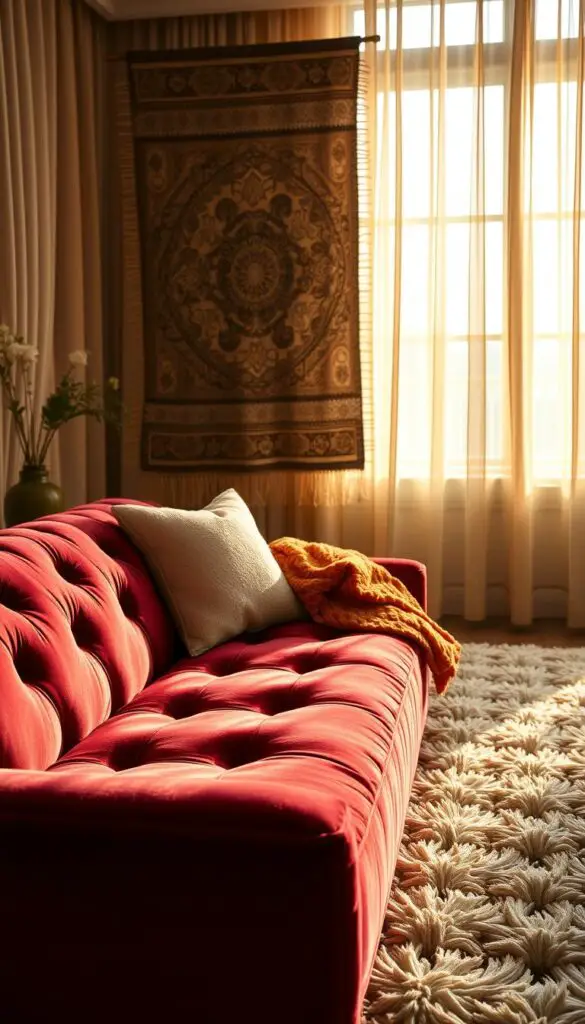
Velvet and Silk for Opulence
Desiree Burns pairs silk drapery with velvet pillows for a tactile contrast that looks rich. Pure silk has luminous depth, but silk-blend fabrics offer easier care. For high-traffic areas, consider these options:
- 100% silk: Ideal for formal spaces (avoid direct sunlight)
- Silk-linen blends: More durable with 20% linen content
- Performance velvet: Target’s Opalhouse line resists stains
Sunlight fades delicate fabrics fast. Rotate velvet pillows seasonally and spot-clean with vodka (yes, really!). It evaporates quickly without leaving water marks.
Textured Rugs to Elevate the Space
A well-chosen rug defines zones while adding softness underfoot. Stark Carpets’ wool designs last decades, but synthetic fibers work for pet owners. Use this formula to find your ideal size:
- Measure seating area width/length
- Add 24-36″ on all sides
- Ensure front legs of furniture rest on it
Layer sheepskin over jute for instant coziness. Always use a thick rug pad—it protects floors and makes thin materials feel plush. The right fabrics and textures turn any space into a sensory experience.
Lighting That Makes a Statement
Lighting transforms a space from ordinary to extraordinary—I learned this after swapping my basic ceiling fixture for a sculptural chandelier. The right fixtures don’t just illuminate; they sculpt shadows, highlight textures, and set the mood. Alvin Wayne’s advice? “Treat lighting like functional art.”
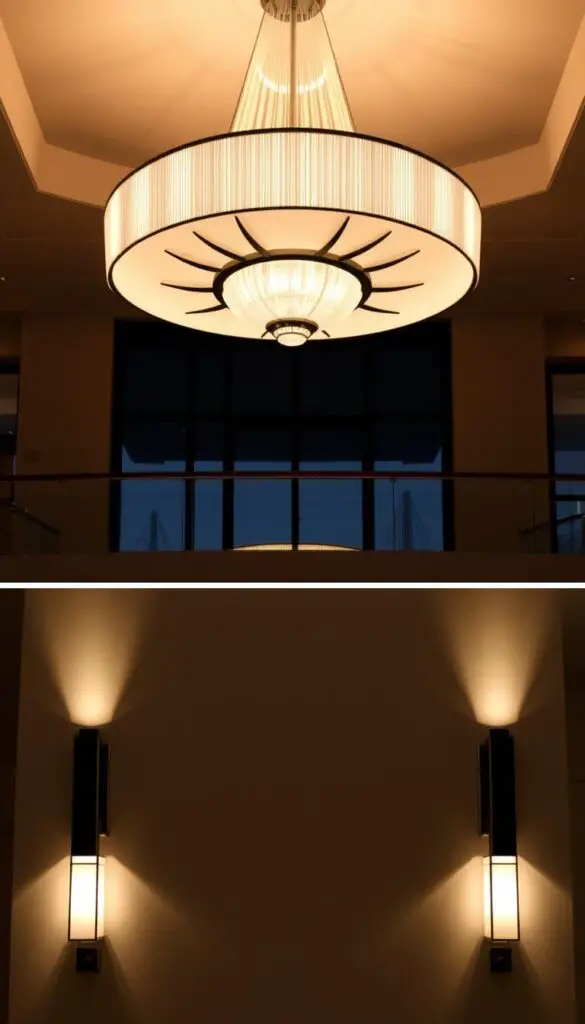
Upgrade Overhead Fixtures
Crystal chandeliers scream classic glam, but modern abstract designs (like Visual Comfort’s Cirque) add edge. For layered lighting, aim for 1,500–3,000 lumens total. Here’s how to distribute it:
- 60% overhead (chandelier or recessed lights)
- 30% task (floor lamps, sconces)
- 10% accent (picture lights, candles)
Unexpected sconce spots: flanking a mirror, above bookshelves, or along a hallway. Always install dimmer switches—they’re non-negotiable for adjusting ambiance.
Artistic Table and Floor Lamps
MR Architecture’s projects prove lamps can be sculptural. A oversized ceramic base or a brass tripod design doubles as decor. For table lamps, the shade should sit at eye level when seated. Avoid my mistake: a 28″ lamp on a petite side table looked comically top-heavy.
Renters can cheat high-end looks with plug-in sconces or battery-powered LED strips under cabinets. Just skip cool-toned bulbs—they cast a sterile glow. Stick to 2700K–3000K for warmth.
Curate a Gallery of Art and Mirrors
Nothing transforms blank walls into conversation starters like well-chosen art and mirrors. I learned this after swapping generic prints for a bold, large-scale art piece—the room instantly felt curated. Designer Desiree Burns says, “Framing is the jewelry for your artwork.” Here’s how to master the mix.
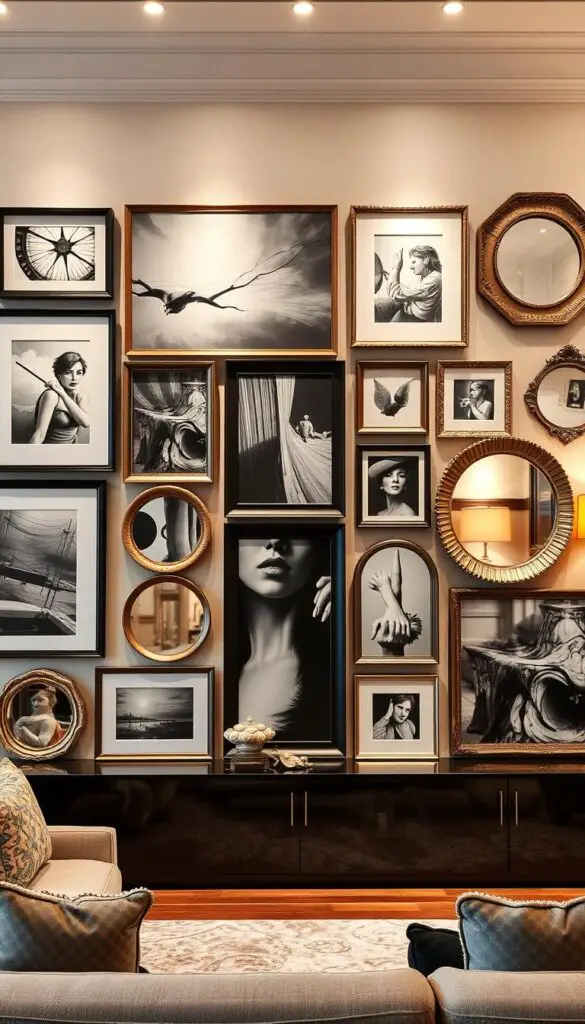
Large-Scale Art as a Focal Point
Oversized canvases anchor a space. For sofas, use this formula: Art width = 2/3 of the sofa’s length. My 72″ sofa pairs perfectly with a 48″ wide abstract painting.
Framing tips from Desiree Burns:
- Custom frames: Ideal for valuable pieces; matting adds museum-quality details.
- Ready-made: Target’s Project 62 offers affordable options for rotating collections.
| Custom Framing | Ready-Made |
|---|---|
| Higher cost ($200+) | Budget-friendly ($30–$100) |
| Preserves art long-term | Easy to swap seasonally |
Gilded Mirrors for Glamour
Rachel Cannon advises, “Place mirrors opposite windows to double natural light.” My antique gilded mirror reflects my chandelier, making the space sparkle.
Cleaning antique finishes:
- Dust with a microfiber cloth weekly.
- Use vinegar-water mix (1:3) for tarnish.
- Avoid harsh chemicals—they strip gold leaf.
For cohesive decor, pair round mirrors with curved sofas or angular designs with modern furniture. Minted and Saatchi Art offer curated collections for every style.
Choose the Right Window Treatments
Window treatments can make or break a room’s elegance—I realized this after replacing my blinds with floor-length drapes. MR Architecture’s designers swear by curtains for their ability to soften lines and add drama. Here’s how to pick the perfect ones.
Ditch Blinds for Sumptuous Curtains
Fabric choice matters. Linen breathes easy for a relaxed vibe, while velvet adds opulence. For a balanced look, consider these pros:
| Linen | Velvet |
|---|---|
| Natural, airy texture | Rich, light-absorbing depth |
| Fades evenly over time | Insulates against drafts |
| Machine-washable (check labels) | Spot-clean only |
Hang curtains high and wide. Measure from the ceiling (not the window frame) and extend rods 6–12″ beyond the window. My 8’ ceilings? Rods at 7’ with 96″ panels create grandeur.
IKEA hack: Add trim to plain panels for custom flair. Use fabric glue for ribbon edges or clip-on rings to fake pleats. The Shade Store’s motorized tracks offer sleek automation—no cords, just quiet luxury.
Avoid plastic hardware. Opt for matte black or brass brackets. For layered home decor, pair sheer linen with blackout liners. Lined curtains block light and reduce energy bills—my winter hack.
Custom drapes cost 3x more but last decades. Ready-made works for renters. Either way, tiebacks should complement your style: tassels for traditional, leather straps for modern.
Incorporate Natural and Faux Greenery
I used to kill every plant I owned until I discovered low-maintenance options. Now, my greenery collection thrives—both real and faux—adding life to every corner. Laura Brophy taught me that plants should complement your lifestyle, not complicate it.
For beginners, snake plants outperform finicky fiddle leaf figs. They survive with monthly watering and tolerate low light. My Sansevieria has lived through three moves and still looks pristine.
When realism matters, Nearly Natural’s olive trees fool even plant enthusiasts. Their 6’ faux tree has weighted trunks and silk leaves that move naturally. Perfect for dark corners where real plants wouldn’t feel at home.
| Planter Materials | Best For |
|---|---|
| Ceramic | Humid spaces, traditional styles |
| Concrete | Modern looks, outdoor/indoor use |
| Fiberglass | Lightweight, easy to move |
Pet owners should avoid lilies and philodendrons—they’re toxic. Instead, try hoya or spider plants. My cat ignores these, and they purify the space naturally.
Style tall plants in empty corners to draw the eye upward. For small areas, preserved moss frames add natural texture without maintenance. Pro tip: Citrus fertilizer keeps leaves glossy—just dilute it to half strength.
Design a Clutter-Free Space
I used to think more decor meant better design—until my coffee table disappeared under trinkets. Designer Laura Brophy taught me that true elegance thrives in clutter-free zones where every item has purpose. The secret? Smart storage solutions and intentional styling.
Built-Ins for Custom Storage
Built-ins blend seamlessly into walls, offering hidden organization without bulky furniture. Laura Brophy’s team transformed a client’s awkward alcove into floor-to-ceiling shelves with concealed drawers. For renters, IKEA’s Billy bookcases mimic this look:
- Paint them wall-color for a cohesive feel
- Add crown molding to the top
- Use baskets or boxes to hide less aesthetic items
The Container Store’s elfa system offers customizable storage with luxury finishes. Glass-front cabinets display curated collections while keeping dust out.
| Open Storage | Closed Storage |
|---|---|
| Great for frequently used items | Hides clutter effectively |
| Requires regular editing | Needs labeling for efficiency |
| Ideal for styled vignettes | Best for bulkier items |
Styling Surfaces with Intention
Megan Molten’s shelf-editing method changed my approach: “Edit until it feels light, then remove one more thing.” Follow these rules for balanced surfaces:
- Leave 1/3 of each surface empty
- Group items in odd numbers (3 or 5 works best)
- Vary heights for visual interest
Console tables shine with simple vignettes—a lamp, small stack of books, and one decorative object. Rotate accessories seasonally to keep the space fresh without overcrowding.
For entertainment centers, adhesive cable clips tame wires. My favorite trick? Run cords through paintable cord covers that blend into walls. A clutter-free space isn’t empty—it’s carefully curated to highlight what matters most.
Focus on the Fifth Wall: The Ceiling
Most people forget the ceiling exists—until they see one that steals the show. I learned this from Megan Molten’s project, where a deep navy paint transformed a bland box into a jewel box effect. Your fifth wall is prime real estate for drama or subtle sophistication.
Tray ceilings add depth, while coffered ones bring classic structure. Here’s how they compare:
| Tray Ceiling | Coffered Ceiling |
|---|---|
| Creates a recessed center | Grid pattern with sunken panels |
| Ideal for modern spaces | Suits traditional design |
| Budget-friendly ($500–$1,500) | Higher cost ($2,000–$5,000) |
For bold statements, try *Farrow & Ball’s* Railings—a near-black hue that feels moody, not oppressive. Metallic finishes? Apply them sparingly. A gold-leaf medallion around a chandelier adds glam without overwhelming.
Low ceilings? Paint them the same color as walls to blur boundaries. Avoid dark tones in north-facing rooms—they absorb light. My best hack: Grasscloth wallpaper overhead. It adds texture and visually lifts the space.
Coordinate ceiling trim with wall moldings for cohesion. For lighting, calculate reflections by placing fixtures at 45-degree angles to highlight textures. The right ceiling treatment ties the whole room together—no crown molding required.
Luxury Living Room Essentials: Small Touches Matter
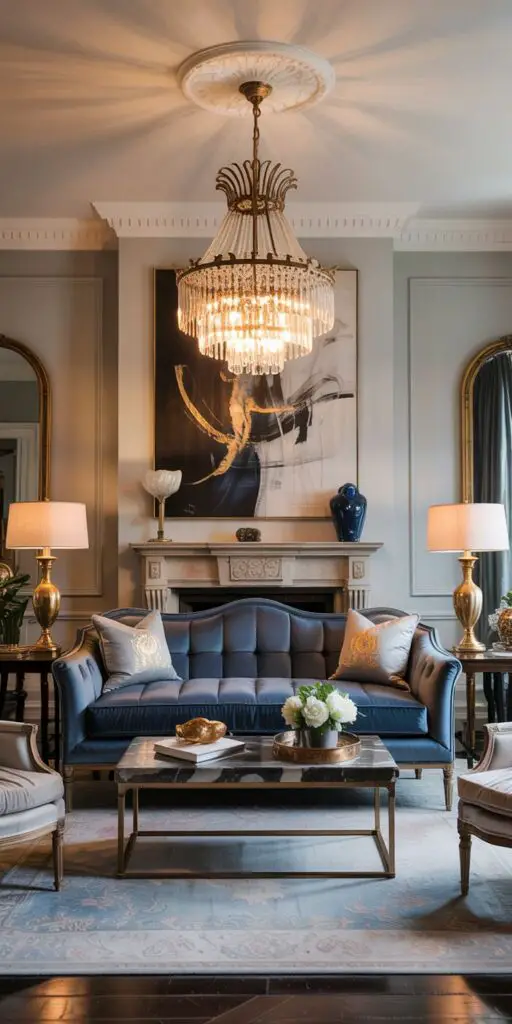
The difference between ordinary and extraordinary often lies in the smallest details. Alvin Wayne once showed me how a marble coaster could elevate a cocktail hour, while Caitlin Kah proved acrylic stools could anchor a space without visual weight. These subtle pieces create polish without overpowering.
Fresh Flowers and Marble Accents
Marble accents add instant refinement. Carrara’s soft gray veins suit minimalist spaces, while Calacatta’s bold streaks make a statement. For budgets, consider:
- Porcelain tiles: Nearly identical veining at 1/3 the cost
- Quartz composites: Stain-resistant and durable
- Contact paper: IKEA-hacked my side table for $15
For fresh flowers, keep arrangements low (under 12″) so they don’t block conversation. Afloral’s faux peonies look real and survive pets. My marble care routine: Wipe spills immediately with pH-neutral cleaner, and avoid citrus—it etches the surface.
Acrylic Furniture for a High-End Illusion
Acrylic furniture tricks the eye into seeing more space. CB2’s Luciano table floats visually, but remember: Weight limits are 25 lbs for most designs. Caitlin Kah’s trick? Use microfiber cloths to combat fingerprints.
Style acrylic with:
- Metallic book stacks (gold or silver)
- Textured throws to contrast transparency
- Single bold artwork to avoid clutter
Mix materials—a marble tray on an acrylic table blends warmth and modernity. Just skip glossy finishes near windows; sunlight yellows them over time.
Conclusion
Creating an elegant space isn’t about perfection—it’s about intentional choices that reflect your style. Every layer, from paint to pillows, builds a cohesive look that feels uniquely yours.
Start small. Swap one decor piece or try a new arrangement. I redesigned my coffee table three times before finding the right balance. Clean surfaces and thoughtful edits keep the space fresh.
Remember, comfort matters most. A stunning home should welcome you, not intimidate. Host friends to celebrate your progress—their reactions will boost your confidence.
Ready to begin? Grab my quick checklist:
- Pick one focal point to upgrade first
- Edit clutter monthly
- Mix textures for depth
Share your transformation! Tag #MyDesignJourney to inspire others. Great style evolves—enjoy the process.
